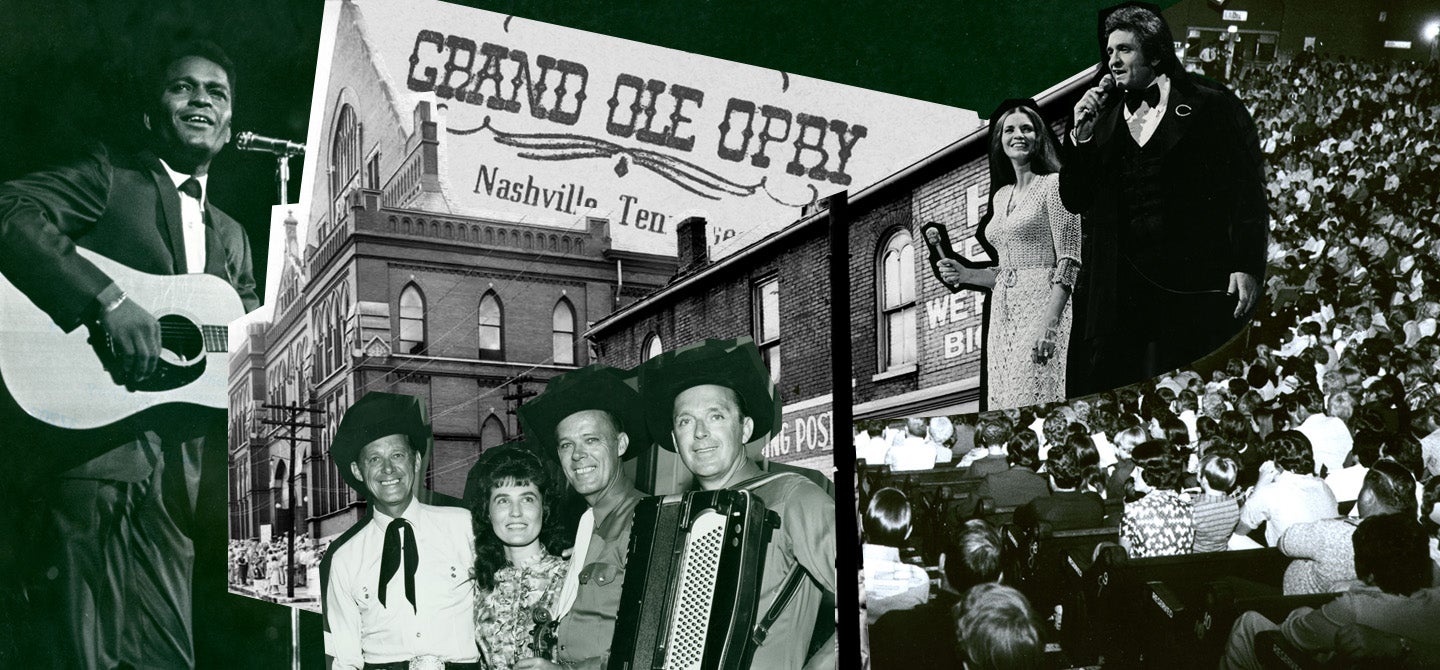
Grand Ole Opry: 1943-1974
CAREERS LAUNCHED. GENRES BORN. MILLIONS ENTERTAINED.
HOW THE GRAND OLE OPRY AND THE RYMAN CHANGED THE MUSIC INDUSTRY FOREVER.
The Grand Ole Opry® began just five years after commercial radio was born in the United States. In 1925, the National Life and Accident Insurance Company built a radio station as a public service to the local community with the hope that the new medium could advertise the brand of the National Life and Accident Insurance Company to the masses. The station’s call letters, WSM, stood for the company’s motto: “We Shield Millions.”
Soon after going on the air, National Life hired one of the nation’s most popular announcers, George D. Hay, as WSM’s first program director. Hay, a former Memphis newspaper reporter who’d most recently started a barn dance show on Chicago radio powerhouse WLS, joined the station’s staff a month after it went on the air. At 8 p.m. on November 28, 1925, Hay pronounced himself “The Solemn Old Judge” (though he was actually only 30 years old) and launched, along with championship fiddler, Uncle Jimmy Thompson, what would become the WSM Barn Dance. Hay renamed the show the Grand Ole Opry in 1927 and its popularity grew rapidly.
Crowds soon clogged fifth floor hallways within the National Life building at 7th and Union downtown Nashville where the WSM studios were located. As more and more people showed up to watch the broadcasts, National Life built an auditorium capable of holding 500 fans. In October 1934, the show moved to the Hillsboro Theatre (now The Belcourt Theatre). Another move came two years later on June 13, 1936, to the Dixie Tabernacle – a 3,500 seat religious revival house with wooden benches, sawdust floors, and no dressing rooms – at 410 Fatherland Street in East Nashville. Next, the Opry moved to a downtown location in July 1939, the 2,200 seat War Memorial. Because the auditorium’s seating capacity was a third less than the Dixie Tabernacle, the show started charging admission – 25 cents. On June 5, 1943 the Opry moved to its most famous former home, Ryman Auditorium, where it stayed for the next 31 years.
The formative years of the Opry were spent on the Ryman stage. The music made on those well-worn planks changed music history, and Nashville, forever. On a cold December night in 1945, Earl Scruggs made his debut with Bill Monroe’s Blue Grass Boys, completing the historic line-up that would serve as the prototype for the bluegrass sound – Monroe on mandolin, Scruggs on banjo, Lester Flatt on guitar, Chubby Wise on fiddle and Howard Watts on bass. In the summer of 1949, a 25-year-old Hank Williams took the stage for the first time to perform “Lovesick Blues.” The crowd gave him such an enthusiastic reception: He was called back for six encores – a house record.
The king himself, Elvis Presley, played the Opry one night in 1954. And in 1956, Johnny Cash was added to the cast. Cash met future wife June Carter for the first time backstage at the Ryman. Upon their meeting he told her he’d marry her someday – he kept his word and they were wed 12 years later. Honky-tonk angel, Patsy Cline, became an Opry member at the Ryman 1960. Cline’s biggest hit “Crazy” was written by a young up-and-coming songwriter, Willie Nelson.
On March 15, 1974, the Opry made its last broadcast from Ryman before moving to its new custom-built home, The Grand Ole Opry House at Opryland. In 2004, the Opry House surpassed the Ryman as the Opry’s most enduring home. In May 2010 during the historic flood in Nashville, the Opry House was severely damaged and as a result received a major renovation. During the construction the Opry revisited two of its former homes, both the War Memorial Auditorium and the Ryman. The newly-improved Opry House reopened September 28, 2010. The show regularly returns to the Ryman during the winter months, November through January.
“The Grand Ole Opry celebrates country music’s diversity,” says Opry general manager Pete Fisher. “In addition, the Opry presents the many generations of artists who have formed country music’s legacy and continue to forge its future course.”
Indeed, during any given Opry show, audiences can expect the best in country, bluegrass, comedy, gospel, and more by Country Music Hall of Famers, cast members who helped establish the Opry as the home of country music, revered superstars, and young artists just starting to make names for themselves.
Today, there are more ways to enjoy the Grand Ole Opry than ever before. The show continues to be broadcast on 650 AM WSM as well as wsmradio.com. Also, the two-hour radio program, America’s Opry Weekend, is syndicated nationwide. Just as country greats grew up listening to the Opry on radio, future generations of Opry stars also may hear it on the Internet, on satellite radio, or via the American Forces Network.
Learn more of our history.
Follow the Ryman’s story from the very beginning. Tour the Ryman today.





